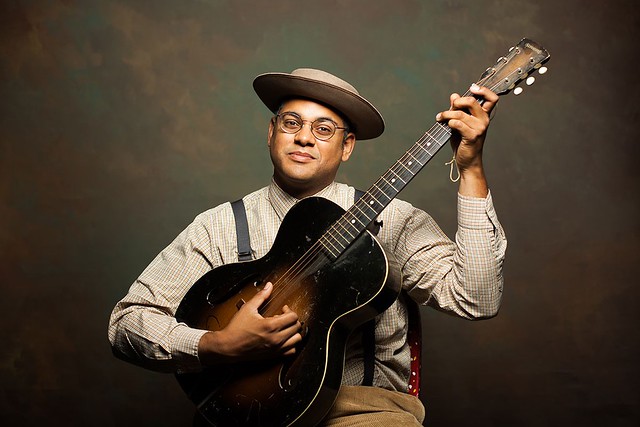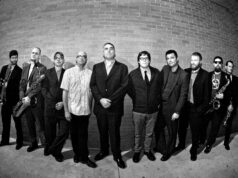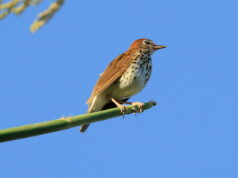
Dom Flemons (Photo courtesy Smithsonian Folkways)
Dom Flemons received a Best Folk Album Grammy Award nomination this past year for his album Dom Flemons Presents Black Cowboys. Black Cowboys sheds a light on the music, culture, and the complex history of the golden era of the Wild West by following the footsteps of the thousands of African American pioneers that helped build the United States of America. In 2010, as a member of the Carolina Chocolate Drops, Dom won the Grammy Award for Best Traditional Folk for Genuine Negro.
In a conversation with Parklife DC’s Mark Engleson, Dom discusses his path from Phoenix to DC, the reception he’s gotten for Black Cowboys and for a broader history of the American West, and his upcoming gig at the Hill Center at the former Naval Hospital on Sunday, June 30.
Mark Engleson: This is Mark Engleson, with ParkLife DC.
Dom Flemons: Hey Mark, how you doing?
ME: I’m doing great. Just out of curiosity, what part of Arizona did you used to live in?
DF: I used to live in Phoenix, Arizona, in central Phoenix.
ME: I just ask because I have family out in Tucson.
DF: In Phoenix, I lived right in the central area. I used to live in the center of the metropolitan area. When I was growing up, early on, it was over off of 21st Ave and Jefferson, which is kind of near the downtown capitol, and sort of northwest of where the stadium is now. But I grew up, obviously, before the Diamondbacks stadium existed. I spent a lot of my years at 16th Ave and Thomas, which is getting toward the north part of Central Ave. Phoenix is kind of set up where Camelback used to be the top of Phoenix, so it’s kind of like halfway in between.
ME: When did you move out to DC?
DF: That was a few different steps. Back in 2005, I went to an event called The Black Banjo Gathering. This is after I had moved out of Phoenix and gone to Flagstaff to go to college at Northern Arizona University. I got my BA in English. I studied ancient literature of all sorts from all over the world. Around 2005, I went to North Carolina. I went to the Black Banjo Gathering. That was where I realized that I could learn more about Southern traditional music. I moved out to Chapel Hill, North Carolina, and I lived there for about five years.
Then I moved up to NYC for about five years as well. I moved back to North Carolina around 2013, and I was there for a few more years. I moved up to DC in 2016. That was after I had performed at the opening ceremonies for the National Museum of African American History & Culture. At that event, I realized that I wanted to my album Black Cowboys and focus on the Smithsonian, Smithsonian Folkways, the African American Museum. It’s because I knew that the story of the Black West was going to be an important one to tell, and I wanted to be here with the Museum. So my wife and I decided to move up. That ended up being a nice move for us. We’re in Silver Spring now.
ME: You came, really, for the resources that support your research and your music?
DF: Well, yes. I had relationships with the Library of Congress from the beginning. Of course, being a fan of the archives at the Library of Congress and the American Folklife Center, I was already drawn to them. I would go visit here and there, Stephen Winick and Jennifer Cutting, and the folks over at Folkways as well. I’d just come and casually visit. It was sort of a natural extension of that part of my relationship with them.
I also have a lot of musician friends out here in DC. My wife worked for Obama during his second term as President, so it was also a familiar place for my wife, too. I moved her down to North Carolina around 2016. We just wanted to have a change of pace. I’d lived in North Carolina for close to 10 years at that point. We just wanted to have a change, get a different scenery. And then, of course, Black Cowboys. I had the album beforehand. Then, when I pitched it Folkways, and they went for it, I just realized I need to be near to the Museum. It just feels like there’s a community that’s building up in the arts in a way that I wanted to be near.
ME: What are you working now on?
DF: Currently, I’m between a bunch of writing projects. I’m working on a collection of songs with my good friends Hank Sapoznik and Dick Spottswood. It’s called Protobilly. That’ll be with JSP Records. It’s kind of a comparative side-by-side with cylinder recordings from the 1890s through 1920s and ’30s early 78s. The theme is around the songs, though. So a song like “Dream of the Miner’s Child,” which is a bluegrass standard, is actually a song that reach back into the 1880s. In a song called “Don’t Go Down into the Mines,” which was an old sentimental parlor ballad, there’s a bit of the history of the song itself and how it fits into the early years of Broadway popular music and the circus at times, minstrel shows — the whole American popular canon.
Then how it’s translated, first into cylinder recordings, which a lot of times are sung and played in the way that they are written on the sheet music. Then they’re being followed by vernacular versions that, one way or another. It’s these very distinctive vernacular versions of songs that have links either to the sheet music directly or their aspect of the song form.
There’s even versions of the songs with various censored lyrics, like “Bully of the Town,” for example, played by the Skilletlickers. They’ve taken out all of the major offensive words from the song to create a whole different song and a whole different intention around the song through performance. That’s one project.
I’m working on a Classic Banjo, Vol. II, with Smithsonian Folkways. These are just kind of writing projects that are continuing to go out there. I’m starting to get into talks about recording a brand new record soon. I don’t have much information to give yet. But there will be another one that is going to be in the works this year. The reactions to Black Cowboys have been so good that it’s really taken me all the way up until this month, in June, to really finally get over the first wave.
ME: Fantastic.
Stream Black Cowboys by Dom Flemons on Spotify:
DF: It’s been really amazing to see it manifest in term of gigs. I’ve done several Western museums this year, which was really great. Western institutions are having some of the same notions that I had when I made the record, which is a desire for diversity and inclusion and the storytelling of the history, without needing to embellish it more — just really bringing out the history that’s actually there so that people can assess that for what it is.
It’s been really neat to be working with these different Western museums to help expand the information that’s already there. It’s just been overlooked, and it’s just that people weren’t necessarily thinking that was the most important story to tell. Now, to know that people want to know about a multifaceted, multicultural West, the album has served as a wonderful conduit for these museums to be able to present their version of the same story, which is really cool.
ME: The problem with history, I always thought, especially where I want to go school, and I’m from Akron, Ohio, in the heart of the industrial Midwest: There was so much emphasis on math and science that history really got the short shrift. There was no depth or breadth to any of it. It’s not that they needed to replace stuff, they just needed to do more.
DF: That’s what I’ve done with a lot of my research. A lot of people want to lean on just whitewashing history being the cause, but when it comes to Black Western history, of course, there’s a lot of misappropriation, segregation, and racism within it. But for a lot of it, you can see that when they wrote the history books, they just didn’t bother with the rest of it.
I feel like now, in the 21st Century, we’re in a very powerful position to be able to actually look at this history and be able to assess it as multifaceted people that are taking it on. I think that, socially, we’re in a lot better place than they were when they were writing these histories 100, 150 years back. It’s been good, though. It’s been great to be able to put this message out there and to see it manifest in different ways all over the country and, at some points, all over the world. It’s been really fun as I’ve been traveling to Europe.
ME: What are some of your favorite places that you’ve gotten to travel to?
DF: I got to go to a couple of new places on this last trip. I went to Spain for the first time. I played one gig in Spain before, but this was my first time getting to see the countryside. I was in Madrid, Zaragoza, which is toward the middle of the country, and then Barcelona. They were right on it with the cowboys, because they understood the Mexican vaqueros are part of their culture. And they have their own cultural history of what cowboys mean, as a Spanish culture. When I approached this project, I did everything I could to include some links to Spanish history, but I knew that that wasn’t a story I was going to be able to tell within the scope of my project. To be able to hear the Spanish people reflect on what they’ve read in the notes that I’ve written and be able to see their own story and have their own spark of cultural memory aroused, that was a beautiful thing.
ME: Spain is interesting, because they got a lot of that horse culture from the Arabs.
DF: Absolutely. It’s pretty amazing how far the world history goes. In some ways, there are some really distinct throughlines that follow different parts of the culture, especially equestrianism and ranching and herding and domesticating — these are things that go back into ancient parts of civilization. Over time, as you have the birth of the United States, the Industrial Revolution, the constant invention of new ideas and new identities, that mixes with the cowboy culture and it creates this phenomenon that still strikes people today as something that is very unique and very different, while still being very rough around the edges in other ways.
ME: There’s always been something about the West, even before the United States, that ties into it. You find also in fantasy literature, and in ancient sources. You find it in Tolkien. You find it in all kinds of places. There’s something about moving Westward.
DF: Absolutely. It’s the new frontier. That’s always the thing. I break down to people as there’s two Wests: the physical West, the part of the United States West of the Mississippi, but then there’s the West of the mind, which includes Manifest Destiny and lot of these bigger ideas of expansion out to new territories to find a new life for yourself. That can really go everywhere; that’s when the whole concept can sprawl out of control, when it comes to the writing of it.
It’s fascinating to see the way that freedom and movement away from the oppression of the place that you’re in is a prevalent thing within that. That’s part of the reason Black Cowboys expanded into being an overview of Black Western culture in kind of a holistic sense, because cowboys are the conduit for it. But it really opens the whole idea of ‘Why are these people moving out west?’ and ‘What are the opportunities that they had, particularly in the years before Plessy v. Fergusson and Jim Crow laws are really set into place?’ You have this 40-50 year period between Emancipation and the strict segregation of the early 1900s where you have people doing a lot of different stuff — quite a lot of people doing a variety of occupations and activities.
ME: I read The Strange Career of Jim Crow, and it’s fascinating how that changes between 1865 and 1900.
DF: I really feel that one of the greatest things that has happened through the use of modern technology has been the access to information that’s available to people that allows them to reach into different schools of thought. I came up right before all of this was stuff people did in their day-to-day lives. But that was part of my training and also my goals as a musician as I’ve gone forward when it came to the historical aspect and telling the cultural stories, I was always making sure to tell the stories of multiple schools of thought, so that people can see that whether an artist is classified as one genre or another they can links to a completely different area of life and of music, just by being there.
It’s been interesting to see that now that all that information has become available to people, people can have a completely outlook on certain aspects of history, or certain aspects of the stories they’ve been told. In the most perfect of constant worlds, they can find new insight because of that. With Black Cowboys, I tried to make sure that this was a kind of a jumping off point so that people could then find new ways to interpret that history.
ME: A lot of these things in history were not especially subtle, there’s just a lot of denial. My dad is retired from the insurance business, when he got into in the early ’70s, he saw people redlining — actually pick up a pen or a marker and redline maps. People just don’t want to acknowledge that it happened.
DF: Because it’s a tough thing to swallow. Then you have to find out why. For the Naval Hospital, is there any specific you like to mention about it?
ME: Yes, tell me about the Naval Hospital. You’re performing there on June 30.
DF: I got the call for it. They’re redoing the old Naval Hospital and it’s going to be amazing venue. It seems like that’s a movement around to DC is to refashion some of the old buildings that are standing well and to be able to put some arts and some cultural activities within. I think that’s a beautiful thing to be able to continue to do. I can’t wait to be over there to represent American roots music and present a variety of the music that is root of all popular music.
ME: That sounds fantastic. I hope to be able to cover that show. My friend Rashad wants to photograph that for you.
DF: Wonderful, wonderful. That’s going to be a great time and I’ll be a doing a variety of materials from blues to country & western to jazz and early ragtime and I’ll be a featuring a variety of banjos: gourd banjo, as well as the standard banjo. I’ll also have the guitar, harmonica. I’ll have a pan pipe known as the quills. I will also be featuring my good friend “Big Head Joe” the giant six-string banjo, a guitar banjo that’s 18-inch diameter putt on it. It’s a big banjo.
ME: That’s a lot of banjos. But can you ever really have too many banjos?
DF: No, you never can. You can’t have too many banjos. In one show, they might have a limit based on the venue.
ME: You’ve got to come prepared right?
DF: Absolutely.
ME: Well, Dom it has been a pleasure. See you at Hill Center at the Old Naval Hospital.
**
Catch Dom Flemons at Hill Center on Sunday, June 30.
Dom Flemons
Hill Center at the Old Naval Hospital
Sunday, June 30
Show @ 4pm
$18
All ages






